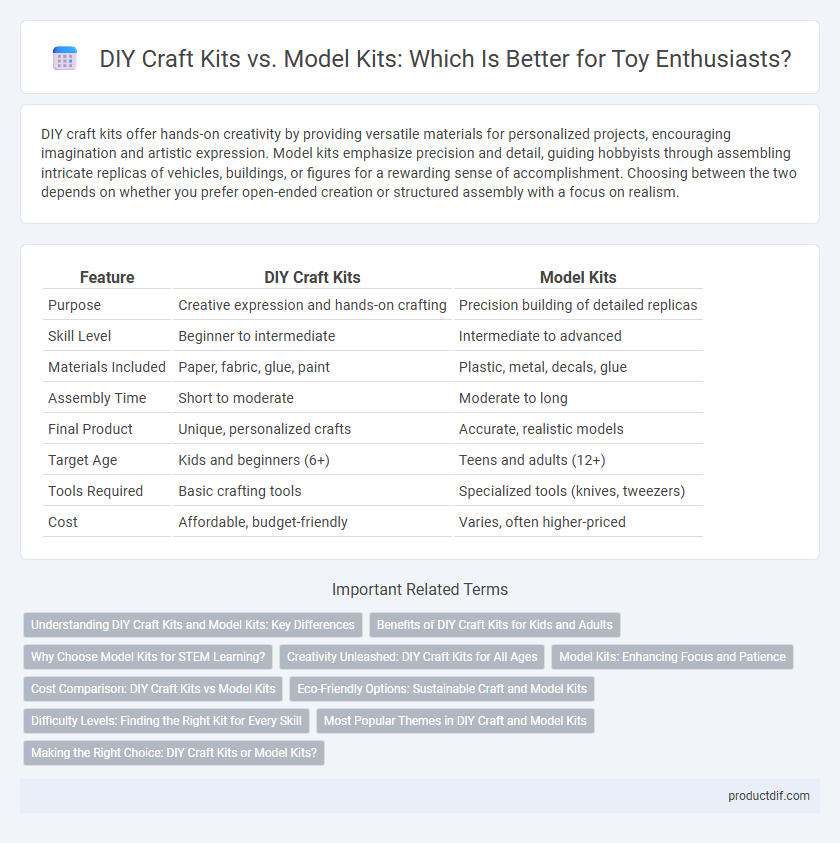DIY craft kits offer hands-on creativity by providing versatile materials for personalized projects, encouraging imagination and artistic expression. Model kits emphasize precision and detail, guiding hobbyists through assembling intricate replicas of vehicles, buildings, or figures for a rewarding sense of accomplishment. Choosing between the two depends on whether you prefer open-ended creation or structured assembly with a focus on realism.
Table of Comparison
| Feature | DIY Craft Kits | Model Kits |
|---|---|---|
| Purpose | Creative expression and hands-on crafting | Precision building of detailed replicas |
| Skill Level | Beginner to intermediate | Intermediate to advanced |
| Materials Included | Paper, fabric, glue, paint | Plastic, metal, decals, glue |
| Assembly Time | Short to moderate | Moderate to long |
| Final Product | Unique, personalized crafts | Accurate, realistic models |
| Target Age | Kids and beginners (6+) | Teens and adults (12+) |
| Tools Required | Basic crafting tools | Specialized tools (knives, tweezers) |
| Cost | Affordable, budget-friendly | Varies, often higher-priced |
Understanding DIY Craft Kits and Model Kits: Key Differences
DIY craft kits emphasize creativity and customization, providing materials and instructions to create unique, personalized projects, often involving various art supplies like paints, glues, and decorative elements. Model kits focus on assembling pre-designed components to build scale replicas or functional miniatures, usually requiring precision tools for detailed construction, such as plastic model airplanes or cars. Understanding these key differences helps consumers choose between open-ended crafting experiences and structured, detail-oriented assembly tasks.
Benefits of DIY Craft Kits for Kids and Adults
DIY craft kits enhance creativity and fine motor skills in both kids and adults by providing hands-on experiences and encouraging imaginative play. These kits often include diverse materials that promote sensory development, problem-solving, and artistic expression. Unlike model kits, DIY craft kits offer greater flexibility, allowing users to customize projects and nurture personal creativity.
Why Choose Model Kits for STEM Learning?
Model kits offer hands-on experience in engineering principles, promoting spatial reasoning and problem-solving skills essential for STEM learning. These kits often include detailed instructions and realistic components, helping learners understand mechanical functions and assembly processes. Compared to DIY craft kits, model kits provide a more structured approach to developing technical knowledge and critical thinking in science, technology, engineering, and math fields.
Creativity Unleashed: DIY Craft Kits for All Ages
DIY craft kits ignite creativity across all age groups by offering open-ended projects that encourage imagination and personal expression. Unlike model kits, which follow precise instructions to build specific replicas, DIY kits provide diverse materials and tools that foster innovation and individual design. These versatile kits support skill development and creative problem-solving, making them ideal for stimulating artistic growth in children and adults alike.
Model Kits: Enhancing Focus and Patience
Model kits engage users in intricate assembly processes that enhance fine motor skills and attention to detail. The step-by-step nature of model kits fosters patience and concentration, making them ideal for developing sustained focus over extended periods. Enthusiasts often experience improved cognitive abilities and a sense of accomplishment through completing complex builds.
Cost Comparison: DIY Craft Kits vs Model Kits
DIY craft kits typically offer a more cost-effective option compared to model kits, with average prices ranging from $10 to $30 depending on materials and complexity. Model kits, especially those featuring intricate designs and licensed themes, often start at $25 and can exceed $100, reflecting higher production costs and detail. Consumers seeking budget-friendly creativity usually find DIY craft kits more accessible, while model kits appeal to hobbyists willing to invest in detailed assembly and realistic finishes.
Eco-Friendly Options: Sustainable Craft and Model Kits
Eco-friendly DIY craft kits often use biodegradable materials like recycled paper, organic cotton, and non-toxic paints to minimize environmental impact. Sustainable model kits incorporate renewable resources such as bamboo and FSC-certified wood, ensuring responsible sourcing and reduced waste. Choosing these eco-conscious kits supports green practices while providing creative and educational experiences for children.
Difficulty Levels: Finding the Right Kit for Every Skill
DIY craft kits offer a range of difficulty levels tailored for beginners to advanced users, making them ideal for creative exploration and skill-building. Model kits often feature precise assembly requirements and intricate details, appealing to intermediate and expert hobbyists seeking a challenging project. Selecting the right kit depends on matching the user's experience with the complexity, ensuring satisfaction and successful completion.
Most Popular Themes in DIY Craft and Model Kits
DIY craft kits often feature popular themes like nature, animals, and seasonal holidays, encouraging creativity and hands-on learning. Model kits frequently focus on vehicles, architecture, and famous landmarks, appealing to hobbyists interested in construction and detail. Both kits cater to diverse interests but differ in thematic appeal, with DIY crafts emphasizing artistic expression and model kits highlighting precision assembly.
Making the Right Choice: DIY Craft Kits or Model Kits?
DIY craft kits offer hands-on creativity, allowing children to personalize projects using various materials like paper, fabric, and paint, which enhances fine motor skills and artistic expression. Model kits, often centered around assembling detailed replicas of vehicles, buildings, or figures, develop precision, patience, and spatial awareness with components like plastic parts, decals, and glue. Choosing between DIY craft kits and model kits depends on whether the focus is on creative freedom or structured assembly, factoring in the child's interests and skill level for optimal engagement and learning.
DIY craft kits vs model kits Infographic

 productdif.com
productdif.com